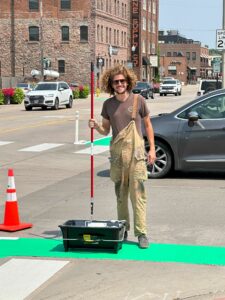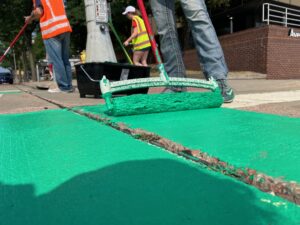Downtown Sioux Falls, Inc. (DTSF) is excited to announce our selection as a recipient of the 2024 AARP South Dakota Community Challenge Grant, which will support our “Lively & Beautiful Streets” (LABS) initiative. This initiative builds on our successful implementation of bump outs in 2019, where strategic installations led to calmer vehicle traffic, increased pedestrian foot traffic, and notable improvements to the streetscape. Thanks to these positive outcomes, the city of Sioux Falls has decided to make key bump out locations permanent, underscoring their effectiveness in enhancing safety and community connectivity.

The painted bump out pilot project in 2024 will have similar goals to that of 2019. DTSF will measure traffic speeds throughout the implementation, and if successful seek to include more permanent features to the downtown cityscape in upcoming city plans. The pilot project is intended to build awareness and ultimately buy-in around pedestrians and vehicles coexisting in a safer way.
The LABS initiative aims to expand on this success by focusing on additional downtown streets, creating environments where slower traffic, safer crossings, and a more hospitable pedestrian realm are the norm. By engaging volunteers to paint curb extensions and enhance walkability, DTSF seeks to make downtown Sioux Falls an even more vibrant and welcoming place for residents and visitors alike.

Erik Gaikowski, state director of AARP South Dakota, emphasizes the broader impact of such initiatives: “AARP South Dakota is committed to collaborating with local leaders to improve residents’ quality of life through tangible changes. We are proud to support this year’s grantees as they make immediate improvements in their communities to jumpstart long-term change, especially for South Dakotans 50 and over.”
Why Traffic Calming is Crucial
Traffic calming measures, such as bumpouts, are crucial for creating safer and more enjoyable downtown environments. These modifications significantly reduce vehicle speeds, making streets safer for pedestrians, cyclists, and drivers alike. By narrowing the roadway at intersections, bumpouts shorten crossing distances for pedestrians, increase visibility, and encourage drivers to slow down.
Moreover, slower traffic contributes to a more peaceful and pleasant urban experience, enhancing the overall quality of life in downtown Sioux Falls. It allows pedestrians to feel more comfortable navigating the streets and fosters community engagement.

Heath Hoftiezer, the Traffic Operations Engineer with the City of Sioux Falls, appeared as a panelist in DTSF’s Walkability forum. When discussing the need for reduced speeds, he mentioned that the average speed on 10th street downtown is 28 mph; 8 above the posted speed limit. Further, he added that we need to use psychology to our advantage when building environments for both pedestrians and vehicles. Piloting bump outs at key intersections is precisely the way to do just that.
Enhancing Walkability and Livability
Walkability is a cornerstone of a thriving downtown. Streets designed for pedestrians not only improve public health and reduce traffic congestion but also stimulate local economies.

A more walkable downtown attracts more foot traffic, supporting businesses and creating a vibrant social hub for residents and visitors alike. Joe Batcheller explains that Walkability is less about a pro-car vs. pro-pedestrian debate, and more about figuring out how everyone can win.

The International Downtown Association has many success stories of implementing “complete street” initiatives via their membership base. One example is the Coxe Avenue Complete Street Demonstration Project. IDA states: “The goal was to design a safer and more enjoyable walking and cycling environment, with temporary and inexpensive materials, while empowering the community to play an active role in transforming their streetscape.”
Reconnecting Communities
The LABS initiative is more than just infrastructure improvement; it’s about reconnecting communities. By making downtown Sioux Falls more accessible and enjoyable, we aim to bring people together in meaningful ways. Whether through safer streets, enhanced public spaces, or increased community engagement, LABS strives to create a downtown that fosters a sense of pride and belonging for all.

During the July Walkability Forum hosted by DTSF, Inc. panelists discussed the importance of considering the various stakeholders early on in the process of designing the streetscape of downtown Sioux Falls. Building a downtown for everyone will take all of us.

Furthermore, it is critical for people outside of DTSF and the City of Sioux Falls to participate in advocacy around walkability, “complete streets”, and other initiatives to strengthen the core of our city. As many others have said, a thriving downtown results in a thriving city.
Get Involved
We invite the community to join us in this transformative project. Volunteers are essential to painting the bump outs and bringing our vision to life. This is a unique opportunity to contribute to a project that will have a lasting positive impact on downtown Sioux Falls.
For more information about the LABS initiative and how you can get involved, sign up to volunteer. Together, we can make downtown Sioux Falls a safer, more beautiful, and more vibrant place for all.

About Downtown Sioux Falls, Inc. (DTSF)
Downtown Sioux Falls, Inc. (DTSF) boldly leads the downtown community by fostering diverse experiences, economic growth, and a healthy environment. Visit dtsf.com for more information.



 Joe Batcheller
Joe Batcheller